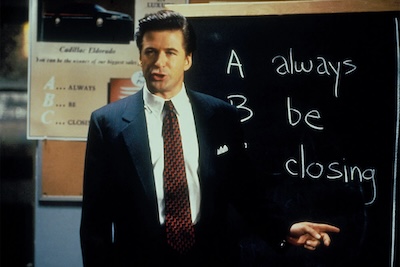‘The Day the Earth Blew Up’ Director Pete Browngardt On Looney Tunes Love, the Art of Falling Down the Stairs
"It's like the films Dumb and Dumber, The Jerk, and Borat; films where characters learn from their experiences but they do not change."
Pete Browngardt is the director and co-writer of The Day the Earth Blew Up: A Looney Tunes Movie. Having worked on the new Looney Tunes Cartoons on Max for years, he shares what it has been like being in that legendary world and what he loves about these characters. In this interview with The Contending, he talks about how is long history and personal affection for these characters gave him insight into what kind of movie he wanted to make. He also shares his other inspirations that ultimately shaped the finished product.
Finally, he shares the secret about why falling down stairs several times can still be really funny.
The Contending: Where did the plot for this movie come from?
Pete Browngardt: I was in production with the Looney Tunes cartoon shorts that are on Max (we did 209 of them) and the studio was asking me if I had any ideas for a Looney Tunes feature. So I thought about it for a little bit and I knew I wanted to do it with Porky and Daffy because they felt like the most pliable for the first feature because they are the only Looney Tunes that are buddies and do not want to kill and eat each other. The buddy comedy shorts from the 30s and 40s were a big inspiration. I also knew I wanted to put them in a genre movie with all the genre parts they played in classic shorts- Duck Dodgers, Rocket Squad, Robin Hood, etc. And I love 40s, 50s and 60s sci-fi, Ed Wood movies, The Day the Earth Stood Still, War of the Worlds, Invasion of the Body Snatchers. These are films that are a big part of why I love film, and I think it is a fun genre to get to play in.
Since I was so busy with production I quickly put together a collage board to see what the movie’s influences would be, and there was a great classic poster of Invasion of the Saucer Men with this big green bulbous head alien on it who is holding a woman. So I took that image and some images of Daffy and Porky and put it together and went and pitched it and I said this is the movie. I do not know what the plot is exactly. I had some other stuff on there like gum and candy. I was trying to think of some images I wanted in the film. They said, “Let’s figure it out, and get you working with a screenwriter.” So I started working with Kevin Costello, and then we added the story team from the shorts who are so great, and that’s why there are so many writing credits for the film. The screenplay is a great starting point, but I believe that animation is made in the storyboard room with reboarding and rewriting. They create the images and a picture speaks a thousand words. I felt like it was important to fight for their credit, which is typically not given for storyboard artists. So that’s how we made the film. We just got together in a room and did it a sequence at a time.
The Contending: Setting up Daffy and Porky for this film we see that they were almost brothers growing up together. But when they are adults from the get-go you can see that Porky is annoyed with Daffy and he has a right to be. We see that Daffy is ruining things for them. Then Daffy eventually has a moment of self-awareness that was fascinating to see in that character. Where did the decision to play with that dynamic come from?
Pete Browngardt: In telling a story like this I knew that it couldn’t be 90 minutes of Looney Tunes jokes. I love telling jokes and writing jokes but I knew to sustain an audience we needed emotional stakes. I didn’t want to change the characters because how do you change iconic characters like that? I wanted them to experience and learn something about themselves or about the other. So that is where it came from. We knew we had to bake that in and track how they feel and how Daffy feels and thinks about himself. That point in the film is where he changes and learns something, but he will always be Daffy Duck. It’s like the films Dumb and Dumber, The Jerk, and Borat; films where characters learn from their experiences but they do not change. That’s what I relate Looney Tunes to.
The Contending: I love the design and personality of The Invader. He looks threatening when we first see him but then you immediately have him cackling so much he starts coughing and he has such an annoyed expression on his face at all times. Peter MacNicol’s voice was great. He is an original character but he fits in the Looney Tunes world perfectly. You touched on some of his inspiration but can you get into more detail about what went into his creation?
Pete Browngardt: It was daunting thinking I have to create a new Looney Tunes character that is going to match up with Porky and Daffy. For his look Bob McKnight and Dan Haskin, these veteran designers, helped. I knew I wanted to do the big brain classic sci-fi thing because of that poster. Then Bob did pages and pages and I looked over it and picked out eyes and expressions I liked. Then we did open casting for The Invader and Peter MacNicol just nailed it, working perfectly with the design of the character. He is such a skilled actor comedically and dramatically that he can play sinister and silly at the same time.
We made the film over Zoom because the production was done during COVID so I didn’t actually get to be in the room with him when we were recording, but watching him perform was so cool, he really envelops the character and personalities. When we were recording, I also found out that he was an animation fan and that he has an animation collection. That was really cool to find out.
The Contending: Loving Looney Tunes and growing up with it is something we’ve all experienced. But now you’ve gotten to be in that world, creating them. What is that like?
Pete Browngardt: It is extremely daunting. When I took on the job of running the shorts that we did for Max people were like, “Are you crazy? Why do you even want to attempt to do that?” It was scary at times. There have been over a thousand Looney Tunes shorts made from the 1930s to the 1960s. They are the greatest cartoon shorts of all time with the greatest characters of all time.
But I thought I could bring something to the characters and I knew the right people to bring together because on my other show, Uncle Grandpa, we had talked about doing Looney Tunes and how great they are. So when the opportunity arose and the studio wanted to make some new shorts I threw my hat in. It was scary but I trusted my gut and my instincts and my tastes. I didn’t try to reinvent the wheel, I wanted it to feel true to who they are. I didn’t do any weird pairings. In my opinion Looney Tunes characters should never live in a house together. They work best as separate entities and, while there are some ways to do some co-mingling, it should be rare.
It has been an amazing experience! It’s like getting to work with Buster Keaton or Charlie Chaplin. These great characters are perfect comedic archetypes and personalities and I get to play with them in my own cartoon dollhouse with these shorts. Daunting but very satisfying, and a dream come true to work on.
The Contending: This film is a laugh a minute and one of my favorites was the scientists falling down the stairs, and you just have a still picture of The Invader as he’s just waiting for it to end. We have seen this kind of joke before but it is still funny and feels new. When you are taking on some of these Looney Tune jokes and we know their sense of humor, what is the challenge in keeping it funny?
Pete Browngardt: It is a hard challenge but also a lot of the credit goes to the great storyboard artists that I mentioned before. That joke you were particularly talking about was Eddie Trigueros, who is an amazing storyboard artist and also a great cartoon director with Mickey Mouse shorts. I think when you’re taking a joke like that you always want to subvert it in some way or bring it to a new level. Take it further or add a new element to it to make it feel fresh. That was important to us. It was also important to take the classic Looney Tunes joke structure and put it in with our contemporary times, with jokes about Uber, Starbucks and Tik Tok. Which can sound a little cringy, but it is all about how you do it, and you also don’t want to do too many of them. Just find the best and spotlight them.
The Contending: We get new details about The Invader that I didn’t see coming and then finding out what Farmer Jim has done for Daffy and Porky in the end was very clever. Without spoiling anything, when did you know you were going to subvert things in the way you did for this film?
Pete Browngardt: That ending subversion was in the script but somewhat different. To find that we had to board the whole thing out and look at it and say, Okay, here is the movie. You always have the script but seeing it is believing in a way. We can see that we’re going to need certain things in certain places. I think that Farmer Jim’s callback came towards the end of boarding where someone came up with it, seeing that that was a way to solve that issue. It made the circle complete. It’s interesting how inspiration can come in so many different ways when you’re writing. The process of animation or filmmaking in general is you are looking at the stuff over and over for years of your life. So it is finding the stuff that continuously entertains you while you are making it, and I think that is the best litmus test of what the audience is going to respond to. I remember hearing this about The Simpsons writing rooms where they would throw jokes out even if it got laughs three times before. It has to keep being funny even after seeing it fifteen times.









